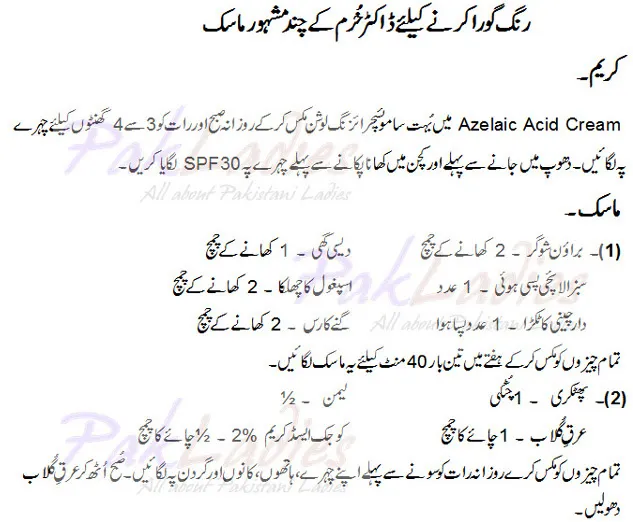What is a Whitening Mask and How Does it Work?
A whitening mask, in simple terms, is a skincare treatment designed to lighten or brighten the skin tone. These masks typically work by inhibiting melanin production, which is the pigment responsible for skin color. They may also exfoliate the skin, removing dead skin cells that can make the complexion look dull. Whitening masks often contain ingredients like vitamin C, kojic acid, arbutin, or other natural extracts known for their skin-brightening properties. The effectiveness of a whitening mask varies depending on the ingredients used, the skin type, and the consistency of use. In Urdu, these masks are often referred to as ‘Safedi Mask’ or ‘Rang Gora Karne Wala Mask,’ which translates to ‘Fairness Mask’ or ‘Skin Whitening Mask.’
Understanding Skin Whitening in Urdu
In Urdu culture, skin whitening is a common beauty goal, often associated with notions of beauty and attractiveness. Many women and men seek methods to achieve a lighter skin tone, whether through skincare routines or cosmetic procedures. The beauty industry in Pakistan and other Urdu-speaking regions is significantly influenced by this preference, with a wide array of products marketed for skin whitening. These products are advertised with claims of achieving a fairer complexion and are readily available in local markets and online stores. Understanding the cultural context is essential because it highlights the importance of skin whitening practices and the need for safe and effective methods that are also aligned with cultural preferences.
Types of Whitening Masks

Whitening masks come in different forms, each offering unique benefits. Some are made with natural ingredients that you can easily find at home, while others are commercially produced and available at cosmetic stores. Understanding the differences can help you choose the best option for your skin type and needs. The main types of whitening masks are categorized by their ingredients. These masks are formulated to provide a range of benefits, from gentle exfoliation to deep hydration and are often designed to target specific skin concerns such as uneven skin tone, dark spots, and hyperpigmentation. The choice depends on personal preference and skin sensitivity.
Homemade Whitening Masks in Urdu
Homemade whitening masks are a popular and often affordable choice for skincare enthusiasts in Urdu-speaking communities. They allow individuals to control the ingredients and avoid harsh chemicals. The use of natural ingredients, such as yogurt, honey, gram flour, and turmeric, is common due to their accessibility and known benefits. These ingredients are often mixed and applied to the face, left on for a specified time, and then rinsed off. Homemade masks are perceived as a gentler and more natural approach to skin whitening, and they are often preferred by those with sensitive skin or those who want to avoid synthetic additives. The emphasis is on using readily available, fresh ingredients and tailoring the mask to individual skin needs and preferences.
Yogurt and Honey Mask
A yogurt and honey mask is a simple yet effective homemade remedy for skin whitening. Yogurt contains lactic acid, a gentle exfoliant that helps remove dead skin cells and brighten the complexion. Honey has moisturizing and antibacterial properties that soothe and hydrate the skin. To make this mask, mix plain yogurt with a tablespoon of honey until well combined. Apply the mixture to the face, avoiding the eye area, and leave it on for 15-20 minutes. Rinse with lukewarm water and pat your skin dry. This mask is suitable for most skin types and can be used a couple of times a week for optimal results.
Gram Flour (Besan) Mask

Gram flour, also known as besan in Urdu, is a staple ingredient in many traditional skincare routines. It acts as a gentle exfoliant and helps to absorb excess oil, making it beneficial for oily and acne-prone skin. To create a gram flour mask, mix gram flour with water, rose water, or milk to form a paste. Apply the paste to your face and let it dry for about 15-20 minutes before rinsing it off with water. You can add a pinch of turmeric for added benefits. The regular use of a gram flour mask can help reduce pigmentation, brighten the skin, and improve overall complexion.
Turmeric Mask for Glowing Skin
Turmeric, a popular spice in South Asian cuisine, is renowned for its anti-inflammatory and antioxidant properties. A turmeric mask can help reduce skin inflammation, lighten dark spots, and give the skin a healthy glow. To make a turmeric mask, mix a teaspoon of turmeric powder with a little bit of yogurt, honey, or milk to create a smooth paste. Apply this to your face, leave it on for 15-20 minutes, and rinse it off. Be careful, as turmeric can stain the skin if not washed off properly, it is important to thoroughly cleanse the skin after use. For best results, use this mask once or twice a week. This mask is particularly effective at improving skin tone and overall radiance.
Commercial Whitening Masks in Urdu
Commercial whitening masks offer a convenient and often more potent option for those seeking skin lightening treatments. These masks are readily available in cosmetic stores and online, featuring advanced formulations with active ingredients. They are typically designed to target specific skin concerns and deliver noticeable results quickly. When selecting a commercial whitening mask, it is crucial to read the label carefully, check the ingredients, and ensure they are suitable for your skin type. Some masks may contain strong chemicals, and it’s always wise to perform a patch test before applying them to the entire face to avoid adverse reactions. The market in Urdu-speaking regions offers a wide variety of options, but caution and informed choices are essential for safe and effective use. Remember to follow instructions on the product label carefully.
Choosing the Right Whitening Mask

Selecting the appropriate whitening mask involves considering several factors to ensure it aligns with your skin type and addresses your specific needs. The first step is to determine your skin type – whether it is oily, dry, combination, or sensitive. This helps narrow down the options. Then, consider the ingredients in the mask. Look for those with proven skin-brightening properties like vitamin C, kojic acid, or arbutin, but also be mindful of potential allergens or irritants. The formulation of the mask, whether it’s a cream, sheet mask, or peel-off mask, will influence the application and effectiveness. Reviews and recommendations can offer insights into the product’s performance, but individual results may vary. Performing a patch test on a small area of the skin before widespread application is crucial to check for any allergic reactions or adverse effects. Finally, consider your budget and the availability of the product. Choose the mask that best fits these criteria.
Ingredients to Look For
When choosing a whitening mask, prioritize ingredients known for their skin-brightening and protective effects. Vitamin C is a powerful antioxidant that reduces melanin production and brightens the skin. Kojic acid and arbutin inhibit tyrosinase, an enzyme that aids in melanin synthesis. Niacinamide, a form of vitamin B3, improves skin tone and reduces hyperpigmentation. Natural extracts such as licorice, bearberry, and mulberry are also beneficial, offering antioxidant and skin-lightening properties. Always check the concentration of these ingredients and choose products with a suitable balance. Avoid products with excessive amounts of harsh chemicals or those that may cause irritation. Look for ingredients backed by research and recognized for their efficacy in promoting a more radiant complexion.
Ingredients to Avoid
Certain ingredients should be avoided in whitening masks, as they can be harmful to your skin. Hydroquinone is a potent skin-lightening agent, but it can cause side effects such as skin irritation, ochronosis, and increased sensitivity to sunlight. Mercury is another dangerous ingredient often found in unregulated products; it can lead to serious health issues. High concentrations of alcohol can dry and irritate the skin. Harsh chemicals such as parabens and sulfates should also be avoided as they can cause allergic reactions. Always check the ingredient list carefully and choose products that are free from these harmful substances. In Urdu, always opt for products that prioritize skin health and safety over rapid results. It’s best to consult with a dermatologist before trying new products, especially if you have sensitive skin.
How to Apply a Whitening Mask Correctly

Applying a whitening mask correctly is essential for achieving the desired results and avoiding skin irritation. Begin by cleansing your face thoroughly to remove any makeup, dirt, or oil. If you have oily skin, consider using a gentle exfoliator to prepare the skin for better absorption of the mask ingredients. Apply a thin, even layer of the mask to your face, avoiding the sensitive eye and lip areas. Follow the product instructions for the recommended time, usually 10-20 minutes. Once the time is up, rinse the mask thoroughly with lukewarm water, ensuring all traces are removed. Pat your face dry with a soft towel and follow up with a hydrating moisturizer to lock in moisture. It is best to apply the mask on a weekly basis, following the manufacturer’s instructions, and always perform a patch test prior to the first full application.
Step-by-Step Guide
Follow these steps for a safe and effective whitening mask application. Start with a clean face, washing it with a gentle cleanser. If using a homemade mask, prepare the ingredients according to the recipe. Apply a thin, even layer of the mask to your face, avoiding the eye and lip areas. Leave the mask on for the recommended time, as specified on the product packaging or recipe. During this time, avoid any facial movements that could cause the mask to crack or dry unevenly. After the specified time, rinse the mask thoroughly with lukewarm water, making sure no residue remains. Gently pat your face dry with a clean towel. Finish with a hydrating moisturizer and, if using the mask during the day, apply sunscreen.
Frequency of Use
The frequency of using a whitening mask depends on the mask type, ingredients, and your skin’s sensitivity. For homemade masks with gentle ingredients, you can use them 1-2 times per week. Commercial masks often provide specific instructions on how frequently to use them, which should be followed. Masks with stronger active ingredients might need to be used less frequently, perhaps once a week or even less, to prevent irritation or dryness. Always observe your skin’s reaction after each use, and adjust the frequency accordingly. It is best to start with a lower frequency and gradually increase it as your skin adjusts. If you notice any redness, irritation, or other adverse reactions, reduce the frequency or discontinue use.
Precautions and Side Effects

While whitening masks can provide benefits, it’s crucial to be aware of potential precautions and side effects. Always perform a patch test on a small area of your skin before applying the mask to your entire face to check for allergic reactions or sensitivity. Common side effects can include mild redness, itching, or tingling. If you experience severe reactions like hives, swelling, or difficulty breathing, discontinue use and seek medical advice. Overuse of whitening masks can lead to skin dryness, irritation, and increased sensitivity to sunlight. Always protect your skin with sunscreen, especially after using a whitening mask. Be particularly cautious when using masks with strong chemicals, such as hydroquinone, as they can cause serious side effects. Pregnant or breastfeeding women should consult a doctor before using these masks.
Benefits of Using Whitening Masks Regularly
Regular use of whitening masks can offer several benefits for your skin. They can help reduce hyperpigmentation, such as dark spots and uneven skin tone, leading to a more uniform complexion. Many masks are designed to promote skin brightening, giving the skin a natural glow. Some masks can also help exfoliate the skin, removing dead cells and revealing a smoother texture. Certain ingredients have anti-aging properties, potentially reducing the appearance of fine lines and wrinkles. Whitening masks may also help to protect the skin from environmental damage due to their antioxidant contents. It’s essential to use the masks consistently, along with a balanced skincare routine, to see significant improvements over time. However, it is important to have realistic expectations and understand that results may vary depending on skin type and the ingredients used.
Tips for Radiant Skin in Urdu
Achieving radiant skin involves more than just using whitening masks. In Urdu, a comprehensive skincare routine is essential. Drink plenty of water to keep your skin hydrated and healthy from the inside out. Eat a balanced diet rich in fruits, vegetables, and antioxidants to nourish your skin. Protect your skin from the sun by using sunscreen with a high SPF every day, as sun exposure can worsen skin discoloration. Get adequate sleep to allow your skin to repair and regenerate. Avoid smoking and excessive alcohol consumption. Consider incorporating other Urdu skincare practices like using rosewater or incorporating natural remedies for added benefits. Always consult a dermatologist to develop a personalized skincare plan tailored to your skin type and specific concerns. Consistency and a holistic approach are key to achieving radiant skin.
Dietary Considerations

A healthy diet is critical for radiant skin. Incorporate foods rich in antioxidants, such as berries, spinach, and tomatoes, to combat free radicals and protect your skin from damage. Consume foods high in vitamin C, like citrus fruits, to help boost collagen production and skin brightness. Include healthy fats from sources like avocados, nuts, and seeds to keep your skin moisturized and supple. Limit your intake of processed foods, sugary drinks, and excessive amounts of dairy, as they can contribute to skin inflammation and breakouts. Drinking plenty of water is also vital to maintain hydration. In Urdu, focusing on a balanced diet that prioritizes fresh, whole foods can significantly contribute to skin health and enhance the effects of skincare treatments such as whitening masks.
Lifestyle Adjustments
Beyond diet, certain lifestyle adjustments can improve skin radiance. Get adequate sleep, aiming for 7-9 hours each night, to allow your skin to repair and rejuvenate. Manage stress through practices like yoga, meditation, or spending time in nature. Avoid smoking, as it can accelerate aging and damage the skin. Limit your alcohol consumption, which can dehydrate the skin and lead to inflammation. Exercise regularly to boost circulation and promote detoxification. Protect your skin from sun exposure by wearing sunscreen, hats, and protective clothing. Developing these healthy habits can enhance the benefits of your skincare routine and lead to a more radiant complexion.
Maintaining Results
Maintaining the results from whitening masks and skincare treatments requires consistent care and attention. Continue using a gentle skincare routine that includes cleansing, moisturizing, and sun protection. Regular use of your whitening mask, as directed, will help keep your skin bright and even-toned. Stay consistent with healthy lifestyle choices, including a balanced diet, adequate sleep, and stress management. Schedule regular appointments with a dermatologist for professional guidance and to address any specific skin concerns. Be mindful of potential irritants and allergens in skincare products. Avoid harsh treatments and excessive sun exposure. By adhering to these practices, you can preserve your radiant skin and enjoy long-lasting results. Remember, patience and consistency are key to any successful skincare regimen, especially in the context of skin whitening.
